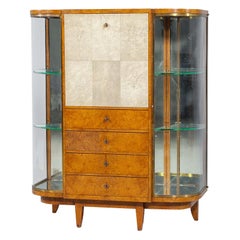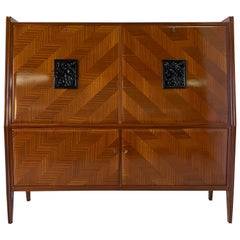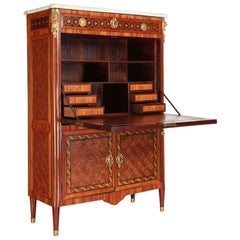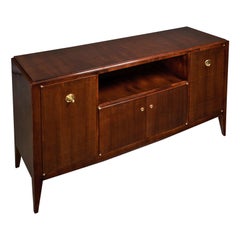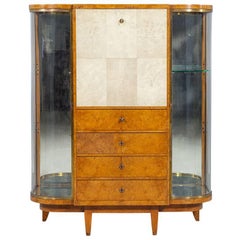Jules Deroubaix Cabinets
to
1
Height
to
Width
to
Depth
to
1
1
1
1
1
1
1
1
1
1
1
1
1
1
1
2
81
75
72
67
Creator: Jules Deroubaix
Art Deco Secretaire Cabinet by Jules Deroubaix
By Jules Deroubaix
Located in North York, ON
This Jules Deroubaix display cabinet secretaire is timeless, functional, and effortlessly chic. Made of burl sandalwood, it showcases a drop door paneled wit...
Category
1930s French Art Deco Vintage Jules Deroubaix Cabinets
Materials
Brass, Chrome
$16,800 Sale Price
20% Off
Related Items
Italian Mahogany Secretaire Cabinet, 1950s
Located in Meda, MB
Precious cabinet secretaire produced in Italy in the 1950s,
The whole cabinet is veneered in mahogany with a fine solid wood carving in the center of the two doors representing two b...
Category
1950s Italian Mid-Century Modern Vintage Jules Deroubaix Cabinets
Materials
Mahogany, Maple
French Ormolu-Mounted Marqueterie Secretaire Abattant, Cabinet, 1775
Located in Rome, IT
Important French ormolu-mounted, kingwood, tulipwood and stained sycamore marqueterie and parquetry secretaire abattant with rectangular moulded white marble top, above a frieze draw...
Category
18th Century French Louis XVI Antique Jules Deroubaix Cabinets
Materials
Wood
$30,522 Sale Price
20% Off
H 55.91 in W 37.01 in D 15.75 in
Burl Walnut Art Deco Cabinet
Located in Dronten, NL
Period Dutch Art Deco secretary in wonderful burl walnut veneer in symmetrical pattern.
Cut-glass pane, drop front desk, ebony wood door handles.
Comes with three beautiful original ...
Category
1920s Dutch Art Deco Vintage Jules Deroubaix Cabinets
Materials
Cut Glass, Ebony, Burl
Art Deco Secrétaire
Located in New York, NY
A practical desk which leaves no aesthetic compromise with its lovely bookmatched mahogany veneer adorning both the inside and outside of the case. Internal drawers are adorned with ...
Category
1930s Swedish Art Deco Vintage Jules Deroubaix Cabinets
Materials
Mahogany
Biedermeier Drawers Writing Desk Secrétaire Cabinet Swedish Ormolu Detail
Located in Lewes, England
Swedish antique Biedermeier writing desk chiffonier secrétaire cabinet in highly quilted golden birch veneers and finished in the Classic light honey color French polish.
It has 2 m...
Category
Late 19th Century Swedish Biedermeier Antique Jules Deroubaix Cabinets
Materials
Birch
$4,345 Sale Price
20% Off
H 38.98 in W 36.23 in D 17.72 in
Charles Spooner Arts & Crafts Oak secretaire Cabinet with Serpentine Stretchers
By Charles Spooner
Located in London, GB
Charles Sydney Spooner, probably made by J H Brandt.
A rare oak secretaire cabinet on stand, with quarter veneered panels to the doors and drawers with black and green diamond shaped handles. The doors open to reveal adjustable shelves. The sides and lower stand are all made from solid quarter sawn oak with beautiful figuring. The slightly graduated mouldings to the waist frame the tidy little writing area. Standing on squashed ball feet, united with serpentine entwined stretchers.
This is an oak variation of the cabinet Charles Spooner exhibited at the Arts and Crafts Exhibition Society in 1910. One can see that both cabinets are essentially the same design, one with drawers one with a pull down writing area. Both have quartered veneered panels to the doors, the Mahogany one with applied moulded decoration to the doors.
See : illustration below from : Arts and Crafts Furniture by John Andrews.
See also : Charles Spooner Arts and Crafts Architect, page 209 illustration 10:28.
: Fine Art Society for a Coromandel variation and Puritan Values : Important Furniture Page 1, for a larger four door lacquered panelled variation.
Charles Spooner is noted as one of the most influential people and also credited as one of the fathers of the Arts and Crafts Movement.
Born at St Mary's Hospital, Paddington (London), Spooner was the second of 5 children of Charles Spooner and Sarah Frances Trinder, who lived at Brook Green, Hammersmith. Spooner became an architect and an instructor of furniture design at the London County Council's Central School of Arts and Crafts. He was a pupil and then assistant of Sir A W Blomfield and in 1890 won the RIBA’s Soane Medallion (Proc RIBA). He specialised in smaller churches and houses turning out some beautiful and complete buildings. He was influenced by E W Godwin and contemporary American architects such as H H Richardson. He was a member of the Society and Protection of Ancient Buildings and the Art Workers Guild, he worked in the tradition of William Morris, teaching...
Category
1920s English Arts and Crafts Vintage Jules Deroubaix Cabinets
Materials
Oak
$11,014
H 78 in W 39.5 in D 16.75 in
18th Century Mahogany Secretaire Bookcase China Cabinet
Located in Lymington, GB
A fine English mid-18th century mahogany secretaire / secretary / bookcase / china cabinet.
Of lovely, deep, rich color, patina and quality.
George III-period, circa 1760.
The bold, detachable, swan-neck pediment carved with 'Gothic' open fretwork, spiral rosettes and a dentil cornice.
The pediment is centred by a small platform below which is a fluted panel. The bookcase / china cabinet section with two, thirteen-pane glazed doors, with three original adjustable shelves with applied beadings for the display of china etc.
The base with a pull-out writing section fitted with small drawers, two of which have secret releases. These secret drawers are faced with blind-fret 'Gothic' tracery, and centred by a carved, shaped arch.
The base with three cock-beaded drawers, and raised on its original bracket feet which are faced with blind fret.
This fine, sophisticated and well-proportioned example of a secretaire / secretary / cabinet / desk / bookcase is remarkable for having survived in its original state including all swan-neck handles and locks.
Of superb quality, color, patination, and well figured throughout. With mahogany drawer linings: further confirmation of its superlative quality.
Measures:
42" wide (107 cm)
23" deep 58.5 cm)
95" high (241 cm) - without cartouche.
A related antique bureau cabinet...
Category
1740s English George III Antique Jules Deroubaix Cabinets
Materials
Mahogany
Regency Brass-Inlaid Rosewood Secretaire Cabinet
Located in Lymington, Hampshire
A Regency brass-inlaid rosewood secretaire cabinet, the rectangular top with a pierced galleried shelf with trellis work on the sides, above a secretaire drawer, banded with brass pa...
Category
1810s English Regency Antique Jules Deroubaix Cabinets
Materials
Brass
Rene Drouet Attributed, Art Deco walnut and Thuya Burr Cabinet
By René Drouet
Located in Saint-Ouen, FR
Rene Drouet attributed, Art Deco walnut and thuya burr cabinet.
Ivory and interior in sycamore veneer.
Secret drawers, original bronzes.
Fully restored. F...
Category
1930s French Art Deco Vintage Jules Deroubaix Cabinets
Materials
Bronze
$14,297
H 53.94 in W 28.75 in D 14.57 in
Michel Pigneres Brass Chrome Black Cabinet Secretaire, 1970s
By Michel Pigneres
Located in Paris, IDF
Unique French Mid-Century Modern cabinet secrétaire by Michel Pigneres made in the early 1970s. This piece is an exquisite example of refined, highly detailed and very well made furn...
Category
1970s French Mid-Century Modern Vintage Jules Deroubaix Cabinets
Materials
Brass, Chrome
18th Century Baroque Cabinet with Secretaire, Germany, 1760
Located in Belmont, MA
18th century Baroque cabinet with secretaire, Germany, 1760, walnut veneer. Beautiful piece in excellent condition, professionally rest...
Category
1760s German Baroque Antique Jules Deroubaix Cabinets
Materials
Walnut
$17,600 Sale Price
20% Off
H 85.83 in W 40.16 in D 21.66 in
Baroque Cabinet with Secretaire, Germany, 1750-1760
Located in Belmont, MA
Outstanding baroque cabinet with fall top secretaire, South Germany, 1750-1760. Beautiful walnut veneer with exquisite figural and landscape marque...
Category
1750s German Baroque Antique Jules Deroubaix Cabinets
Materials
Elm, Walnut
Previously Available Items
Elegant Polished Wood Cabinet by Deroubaix, France, circa 1950
By Jules Deroubaix
Located in New York, NY
Jules Deroubaix (1904-1979)
An elegant four door cabinet in mahogany stained fruitwood with central open niche,
polished brass mounts.
Signed, maker's stamp on back
France, 1950s...
Category
1950s French Mid-Century Modern Vintage Jules Deroubaix Cabinets
Materials
Wood
Art Deco Burl Sandalwood Wood and Shagreen Secretaire Cabinet by Jules Deroubaix
By Jules Deroubaix
Located in North York, ON
This Jules Deroubaix display cabinet secretaire is timeless, functional, and effortlessly chic. Made of burl sandalwood, it showcases a drop door paneled with gorgeous shagreen to ad...
Category
1930s French Art Deco Vintage Jules Deroubaix Cabinets
Materials
Brass, Chrome
H 51.25 in W 42 in D 18.5 in
Jules Deroubaix cabinets for sale on 1stDibs.
Jules Deroubaix cabinets are available for sale on 1stDibs. These distinctive items are frequently made of wood and are designed with extraordinary care. There are many options to choose from in our collection of Jules Deroubaix cabinets, although brown editions of this piece are particularly popular. Many of the original cabinets by Jules Deroubaix were created in the mid-century modern style in france during the mid-20th century. If you’re looking for additional options, many customers also consider cabinets by Maxime Old, Michel Pigneres, and Maison Jansen. Prices for Jules Deroubaix cabinets can differ depending upon size, time period and other attributes — on 1stDibs, these items begin at $16,800 and can go as high as $29,500, while a piece like these, on average, fetch $23,150.
